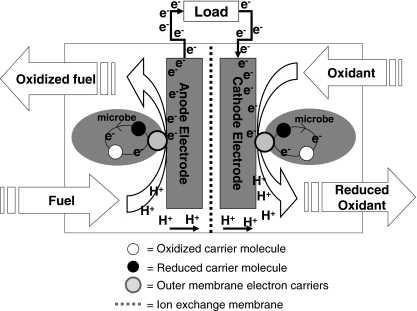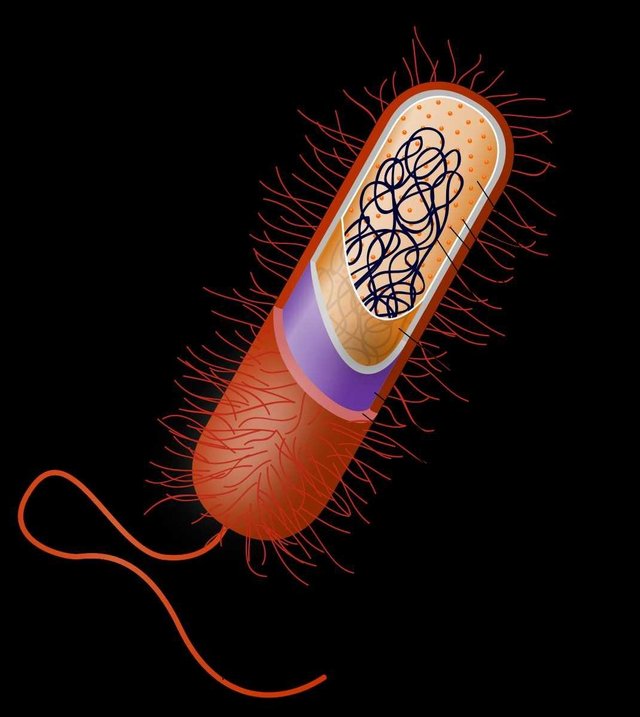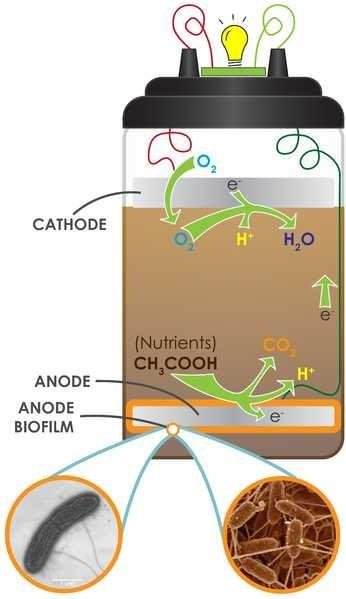Microbial Fuel Cell Technology: Curbing Pollution And Generating Electricity Via Bacteria Action
Hey guys. And good lovers of this page. I welcome you to my blog. This article was supposed to be uploaded yesterday but I mistakenly pressed "discard button" and the article erased before my eyes. It was really maddening, and I have never felt so bad. Thanks goodness I am back now, and here we go again.
 )[*A typical MFC powering a small fan with its generated electricity*. Source: [Wikimedia commons](https://commons.m.wikimedia.org/wiki/File:Microbial_fuel_cells_with_small_fan_(on_the_right)_powered_by_the_electricity_produced._(13358699875).jpg). Author: SuSanA. [CC BY 2.0](https://creativecommons.org/licenses/by/2.0/deed.en) licensed]
)[*A typical MFC powering a small fan with its generated electricity*. Source: [Wikimedia commons](https://commons.m.wikimedia.org/wiki/File:Microbial_fuel_cells_with_small_fan_(on_the_right)_powered_by_the_electricity_produced._(13358699875).jpg). Author: SuSanA. [CC BY 2.0](https://creativecommons.org/licenses/by/2.0/deed.en) licensed]Governments all over the world are shifting focus to renewable sustainable and pollution-free fuels because fossilized fuels, like petroleum and its likes, are exhaustible and contribute to the worsening environmental pollution. Even governments of oil producing countries are realizing that crude oil is not a strategic economic resource. It is exhaustible and therefore makes no economic sense for government to continue to depend on it as a viable means of earning foreign exchange.
Due to the health hazards posed to humans by fossilized fuels, their limited supply and being no strategic means of foreign exchange, a lot of funds are being expended on researches that are tailored at discovering worthy alternatives, which have led to some noteworthy achievements. I have written articles here, here and here on some recently discovered worthy alternatives that are being perfected as replacements to fossilized fuels. The theme of today's article will be on another source of alternative energy, and I don't intend to stop here; I will reveal some more sources in my future articles.
That being said, most of us know that we can harvest renewable energy from sun (solar energy), wind, water (hydropower), or earth (geothermal energy). But do you know that we can generate electricity and, at the same time, convert harmful organic wastes to harmless by-products via bacteria action in devices known as **Microbial Fuel cells (MFCs)? Yes we can; how this is possible forms the basis of this article.
By using MFCs with appropriate isolates of bacteria species, we can harvest electricity while ridding our environment of harmful organic wastes including PCBs (Polychlorinated biphenyls), sewage, mud, and other toxic chemical pollutants. Although the technology is still evolving, however, when this system is perfected, we will have the capacity to generate electricity at low cost while also transforming domestic, industrial and farm toxic pollution into harmless end products all via bacteria action! Nothing can be so beneficial! Ain't it?
 )[*Schematic of an MFC*. Source: [Wikimedia commons](
)[*Schematic of an MFC*. Source: [Wikimedia commons]( ). Author: Bretschger O. et al. [CC BY 3.0](https://creativecommons.org/licenses/by/3.0/deed.en) licensed]
). Author: Bretschger O. et al. [CC BY 3.0](https://creativecommons.org/licenses/by/3.0/deed.en) licensed]Now, we have known that it is possible to generate electricity and transform harmful organic substrates using bacteria in MFCs. However, the question is how does this happen? In other words, where does the electrical current come from and how was the electrons transfered and captured in order to generate the said electricity? These bring us to the concepts of breathing metal and bacterial "wires" which I will be explaining in the subsequent paragraphs.
The concepts of breathing metal and bacterial "wires" — the secrets behind MFCs
Some species of Bacteria have been found to have natural ability to produce electricity under anaerobic conditions. This, according to some studies, is due to their ability to breathe solid lumps of iron in the soil. These group of bacteria occur naturally in places with limited sources of oxygen such as sewage, mud, wastewater. And use the said process during which they generate electricity to actually breath in the absence of oxygen. This electricity can be harvested using MFCs.
To successfully harvest this electricity using an MFC, then there is a need to have a mechanism that transports electrons between the anode and cathode electrodes. And this is where the concept of bacterial wires enters. In a simple MFC, there is no intermediate mechanism to effect this electron transfer other than bacteria. Bacteria have to reach out and touch the anode for electrons to flow and generate electrical current. To do this, according to the work of Professor Derek Lovley and his team of researchers at University of Massachusetts at Amherst, bacteria have to produce some unique filamentous (or pili) structures that have the capacity to transfer electrons in the same way a metallic conductor does. This biological filaments or pili that can act like metal is known as nanowires because, in fact, they are tiny wires.
 )[*A typical procaryotic bacteria cell showing nanowires (pilus)*. Source: [Wikimedia commons](
)[*A typical procaryotic bacteria cell showing nanowires (pilus)*. Source: [Wikimedia commons](These nanowires are capable of joining together to form a conductive biofilms when billions of bacteria are grown together. Conductive biofilms can transfer electrons across a long distance, making them the most suitable material for growing organic and self-repairing electrical conductors in the future. Such conductors have potential to be used in biocomputers.
Sample Microbial Fuel cell (MFC) and how it works
Basically, MFC comes in different types but for the purpose of this article, we will be using just one type to represent the working mechanism of a typical MFC.
An MFC comprises two electrodes — anode and cathode. While anodic chamber, which contains the bacteria, is sealed off to enable anaerobic condition, cathodic side is exposed to the air. A solution that's consisting of organic matter and microbes is used as fuel. In the course of their normal metabolic activities, bacteria breath out electrons onto anode. The released electrons travel via an external circuit to produce electricity. This system as it is, is known as electrochemically inactive microbial fuel cell. This means that the electrons from microbes are not readily carried to anode, making the system to work at a very low efficiency.
 )[*How a typical MFC works*. Source: [Wikimedia commons](
)[*How a typical MFC works*. Source: [Wikimedia commons]( ). Author: MFCGuy. [CC BY-SA 3.0](https://creativecommons.org/licenses/by-sa/3.0/deed.en) licensed]
). Author: MFCGuy. [CC BY-SA 3.0](https://creativecommons.org/licenses/by-sa/3.0/deed.en) licensed] Organic compounds called exogenous mediators including thionine, neutral red, humid acid, methyl blue, and methyl viologen can be added to act as shuttles for electrons, delivering electrons to anode and diffusing back to bacteria. And hence increasing the efficiency of the system. However, these mediators are expensive and can be toxic too, and thus engendering the need for alternate solution.
This is provided with the discovery of certain bacteria that produce electrically conductive appendages. Commonly used in MFC are Shewanella oneidensis and Geobacter sulfurreducens. Their nanowires readily facilitate the transfer of electrons to anode and greatly increased the efficiency of the MFC. It is noted that the efficiency is increased by six times in when solution of other microbes are added (i.e in a mixed culture).
Conclusion
Even as revolutionary as MFC may be with its characteristics ability to render harmful organic wastes harmless while generating electricity at the same time, it will take some time before the technology will be commercialized for public use. Presently, wide scale applications are limited by low power output and high cost of production. However, man has always strive to innovate. When MFC is perfected and mass produced for public use, it would help the world resolve energy crisis and pollution problems. Thanks for reading.
References for further reading
- Microbial wires, an electronic dream
- Microbial Fuel Cell
- Meet the electric life forms that live on pure energy
- Bacteria eating pollution and generating energy
- Double bonus: bacteria eat pollution, generate electricity
- Mud power: how bacteria can turn wastes into electricity
- Microbes to generate electricity
Yours truly,
@eurogee
Do You Blog About Science, Technology, Engineering, and Mathematics? If Yes, Patiently Read The Below Info


Join Euronation Community on Telegram and whatsapp through the below links to socialize with larger steemit community:

No Witnesses = No Steem Blockchain; If You Truly Love Here, Vote For Witnesses NOW!
Click This Link To Vote Now


Wow. I was already thinking that it cant be the common salmonella and E. Coli and all this common enterobacteriacea. I know many research has been done on it. That cant just be now. But anyway when those bacteria you mentioned is mixed with the enterobacteriacea can it still be used for MFC... Thank you for educating us on this @eurogee
When the most common organisms I described here are in a mixed culture with those you mentioned in an MFC, the efficiency is greatly enhanced. Thanks for the insight
@eurogee
Nice one, I hope my country skips the conventional method of electricity supply (which we currently are struggling with) down to the revolutionary MFN
Still a long way to go. Thanks
Microbial fuel cell is one of the areas I have penned down for future article. Kudos to you on this. Might still write on it all the same
Do it sir. Looking forwards to read your piece. Your command of English is 👌, explaining why I love being on your blog.
Regards
Hi @eurogee!
Your post was upvoted by utopian.io in cooperation with steemstem - supporting knowledge, innovation and technological advancement on the Steem Blockchain.
Contribute to Open Source with utopian.io
Learn how to contribute on our website and join the new open source economy.
Want to chat? Join the Utopian Community on Discord https://discord.gg/h52nFrV
I'm really excited about this technology on the whole. Loosely related is the plants that are being genetically engineered to glow, replacing street lamps - even stopping their glow when the sun comes out!
Crazy times we're in. Glad you finally got this post out =P
Thanks @mobbs. I am glad you like it. On the florescent plants, I am aware of it. It's an exciting technology. And we are looking forwards to its commercialization.
Appreciate your visit
@eurogee
Great article but i think there is some errors with the code.. You can take time to look at it sir.
My brother, the formatting of this work had taken me entire day to no avail. I uploaded using eSteemApp and that's the issue. It looked good on eSteemApp but scattered when steemitis used to view it. Tried fixing it but failed. Don't know why. But this won't happen again. Thanks.
Hi @eurogee somebody might be able to help you fix the code in the discord channel (it just appears to be your images). It is a great article, I wonder what progress and results have been obtained so far?
Yes concrete result has been achieved but the power generated is low but was able to power small bulbs and fan as shown in the first picture. However, it's being worked on to improve it before being commercialized. Thanks
Eyaa.. What happened might just be little error in the code.. I suggest you take a look at it on steemit.. Delete the showing stuffs "[image](" for example and the closing part and remove the space i think it should be okay. Do it on steemit.
I tried had tried your recommendations sir. First, the space is closed on eSteemApp and when I closed it on Steemit, the pix didn't show. This is also the result I get when I removed those extra brackets. Quite saddening.
Then its more complicated than i thought... These things could be really frustrating.
Yes able Steemian. Your brother have seen fire on this particular article. Taking a day off writing articles because of this. Today is only commenting I will be doing 😂
you could try out html image tag Sir. that was what i used for mine
When I read stuff about regeneration of things and conservation of the environment in the process
I get really excited. (This to me is the most interesting part of bio-technology)Thanks for sharing
Welcome!
Great post, this technology has huge potential. One thing we will never run out of in the world is bacteria.
Exactly. Thanks for the addition